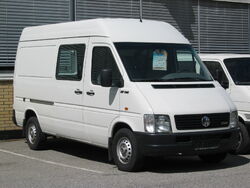 | |
| Manufacturer |
initially: Volkswagen, later: Volkswagen Commercial Vehicles |
|---|---|
| Production |
Typ 28: April 1975–July 1991 Typ 21: August 1991–December 1995 Typ 2D: May 1996–July 2006 |
| Successor | Volkswagen Crafter |
| Class | Light commercial vehicle |
| Body style(s) | Van (Cargo/Passenger), Pickup, Minibus, Crew cab, Chassis cab |
| Layout |
Front engine, rear-wheel drive or four-wheel drive |
| Platform | Volkswagen Group LT/T1N series |
The Volkswagen LT was the largest light commercial vehicle panel van produced by Volkswagen (and subsequently Volkswagen Commercial Vehicles as of 1996) from 1975 to 2006. Two generations were produced.
1st generation LT (Typ 28/Typ 21)[]
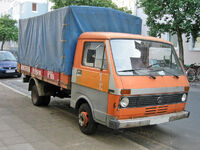 | |
| Manufacturer | Volkswagen |
|---|---|
| Also called | LT 28, LT 31, LT 35, LT 40, LT 50, LT 55 |
| Production | April 1975–December 1995 |
| Width | 2.02 m (6.6 ft) |

Early LT 31 double chassis cab
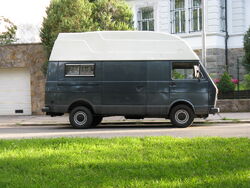
LT 35e LWB with a custom camper high roof
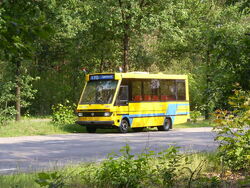
Defunct Dutch minibus based on LT 50 chassis
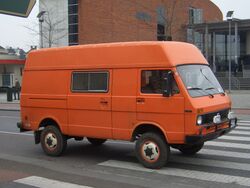
1980 LT 40D Sülzer 4x4

First generation post-facelift LT
History[]
Volkswagen introduced the Volkswagen Type 2 in 1950 and developed light commercial vehicle versions for German and European markets. The name "Kombi" (the name under which the Type 2 was sold in Brazil) established itself as a concept term to describe an entire light commercial vehicle segment. The automaker introduced the revised Volkswagen Type 2 (T2) in 1968. Commercial customers were shipping heavier and larger-volume freight. The Volkswagen Type 2 platform was also limited by its rear-mounted engine design.
Design[]
The new design specifications for a larger transporter as an additional series ranged from 2.8 tons gross vehicle weight to 3.5 tons. The layout was a conventional rear drive with the engine located above the front axle, in a cab over design.
The new Volkswagen van was launched in 1975 in Berlin. The name given to Volkswagen's large transporter was as functional as the entire vehicle: it was just called LT, which is simply the abbreviation of Lasten-Transporter (or cargo transporter).
The LT came in three gross vehicle weights, from 2.8 to 3.5 tons (LT 28, LT 31, LT 35), with two wheelbases, two roof options, and with bodywork options as a panel van, a compact, a platform vehicle and a chassis cab combination.
The design featured a high ratio of utility space to footprint due to its cab over design and overall width of 2.02 metres (6.6 ft). The compact LT panel van (with a little over four and a half meters in length) offered an interior load length of over three meters and a load area of around 5.5 square metres.
Engines[]
The LT was equipped with a front axle with independent front wheel suspension. Later options, such as the heavy LT 40 to LT 55, had a solid front axle to achieve increased to load-carrying capacity as is common for light trucks.
The petrol engine was a modified Audi 100 2.0 L inline four-cylinder. It was rated at 55 kilowatts (75 PS/74 bhp) and achieved higher torque at lower engine RPMs.
An inline four-cylinder diesel engine by Perkins was available. The 48 kilowatts (65 PS/64 bhp) 2.7-litre diesel was included in the LT range from 1976 onwards.
The Perkins engine was replaced in 1978 with a six-cylinder variant of the Volkswagen Golf diesel. The original 1.6 L four-cylinder engine became the D24 2.4 L six-cylinder, delivering 55 kilowatts (75 PS/74 bhp).
In December 1982, an upgrade to the LT was introduced. The six-cylinder diesel was available as a turbodiesel, the Volkswagen D24T engine, producing 75 kilowatts (102 PS/101 bhp) and 195 newton metres (144 ft·lbf) of torque. In addition, the six-cylinder engine was now also available as a 66 kilowatts (90 PS/89 bhp) petrol engine. All engines were now mounted with a clear offset alignment that allowed for a flatter engine compartment, which was shifted further to the rear for more space for a third seat in the cab.
In 1986, an overhauled turbo-diesel engine with charge air cooler and 70 kilowatts (95 PS/94 bhp) was introduced - the Volkswagen D24TIC engine.
Facelifts[]
A facelift in 1986 changed the round headlights to rectangular units, as well as other minor cosmetic retouches. In Spring 1993, there was again a modest change in the look, with new grey-plastic elements introduced to the radiator grille and in the rear lighting section.
The second phase of the first generation LT in 1983 also included a redesigned dashboard, and the undercarriage had an additional third wheelbase as an option for platform-type vehicles, at up to 4.6 meters in length.
Two years later, Volkswagen again increased the gross vehicle weight, with the 5.6 ton LT 55. It was available with a single-tyre rear axle —allowing for more space between rear wheel wells inside the cargo floor. An LT with four-wheel drive that could be enabled from within the cab was also available.
Campervan versions[]
A touring camper in its various bodywork and fitting options was also produced. The vehicle's width allowed the possibility of beds arranged crosswise. Various Volkswagen-endorsed Westfalia campervan models were available for the LT, including the Sven Hedin, and a later model,Florida. The LT was also used by Karmann who produced over 3,000 Karmann LT Distance Wide coachbuilt motorhomes.
Truck cabs[]
The "G Series" light truck was a joint venture between Volkswagen and MAN AG, with gross vehicle weights of between six and ten tons. It was built from 1979 until 1993.
Volkswagen's Brazilian plant at Resende has been constructing trucks with weights of between 7 to 35 tons. Even after the launch of the new Volkswagen Constellation in 2006, Volkswagen Commercial Vehicles has continued to manufacture vehicles incorporating cabs based on the first generation of the LT. The Volkswagen Titan has succeeded in winning the European Cup in the Super Truck Race. Its cab is similarly based on the first generation of the LT's cab.
Rebadging[]
In the late eighties, German-built Volkswagen LT and MAN-VW G were sold in Spain as Pegaso Ekus, while Brazilian-built units were marketed in USA as Peterbilt Midranger. A 4x4 version was sold in Austria as the Steyr-Puch Noriker.
Typ codes[]
The Volkswagen "Typ codes" for the first generation LT were:
- Typ 28 — April 1975 to July 1991
- Typ 21 — August 1991 to December 1995
The last first generation LT was produced in 1996, which corresponds to a British 'P' registration plate. In 21 years, just under 5000,000 vehicles were assembled.
2nd generation LT (Typ 2D)[]
 | |
| Manufacturer | Volkswagen Commercial Vehicles |
|---|---|
| Production | May 1996–July 2006 |
| Successor | Volkswagen Crafter |

2nd gen. LT 28 operated by a German "Behindertenfahrdienst" (handicap transport service)

LT minibus in Spain, with adaptations for carrying disabled people

LT 28 'crew cab'
History[]
In 1996, the joint venture of Volkswagen and Daimler's Mercedes-Benz Commercial introduced the second generation LT. The Volkswagen version shared the body shell with the new Mercedes-Benz Sprinter, however the engine and transmission were Volkswagen Group sourced. This deal would continue in the Volkswagen Crafter, successor to the LT.
The new design incorporated an engine mounted longitudinally beneath a short hood and with rear-wheel drive. The LT adopted what had become the standard style of construction for bigger transporters. It also included economical direct-injection diesel engines, easy access to the driver cab behind the front axle, and a wide space between the driver and passenger seat.
The range now went from 2.6 to 4.6 tons gross vehicle weight, and the enclosed options of the panel van and compact were available in three wheelbase options. Platform vehicles, crewcabs and numerous undercarriage options completed the range. A special articulated version of the second generation LT, the XLT was available through special order.
Engines[]
Engines included a naturally aspirated engine, as well as three Turbocharged Direct Injection (TDI) diesel engines. These were the inline-five-cylinder TDI used in the Volkswagen Eurovan (Type 2 T4). The performance range for the LT initially went from 61 kilowatts (83 PS/82 bhp) to 96 kilowatts (131 PS/129 bhp). In January 2002, an inline-four-cylinder 2.8 litre engine increased power output to 116 kilowatts (158 PS/156 bhp), and the maximum torque to 331 newton metres (244 ft·lbf).
The 2.8-litre engine's specifications:
- 2,789 cubic centimetres (170.2 cu in) inline-four-cylinder, 93 mm bore, 103 mm stroke and three valves per cylinder
- rated output: 116 kilowatts (158 PS/156 bhp) EEC @ 3500 rpm; 331 newton metres (244 ft·lbf) @ 1800 rpm
- Diesel common rail fuel system
The 2.5-litre:
- 2,461 cubic centimetres (150.2 cu in) inline-five-cylinder, 81 mm bore, 95.5 mm stroke, 19.5 compression ratio, and two valves per cylinder
- rated output: 80 kilowatts (109 PS/107 bhp) EEC @ 3500 rpm; 280 newton metres (207 ft·lbf) @ 1900 rpm
- Diesel direct injection fuel system (Bosch VP37 belt driven pump with two-stage nozzles)
- KKK K14 turbocharger
Typ codes[]
The Volkswagen "Typ codes" for the second generation LT are:
- Typ 2D — May 1996 to July 2006
Replacement[]
Production ended in Q4 2006 with about 350,000 LT models produced on over nine years. Plans for the third generation of the 'large transporter' from Volkswagen Commercial Vehicles had already gone underway, and later that year the Volkswagen Crafter was launched.
See also[]
- Volkswagen D24 engine
- Volkswagen D24T engine
- Volkswagen D24TIC engine
References[]
- ETKA[clarification needed]
| This page uses some content from Wikipedia. The original article was at Volkswagen LT. The list of authors can be seen in the page history. As with Tractor & Construction Plant Wiki, the text of Wikipedia is available under the Creative Commons by Attribution License and/or GNU Free Documentation License. Please check page history for when the original article was copied to Wikia |
External links[]
- VW Australia official LT site.[dead link]
- LT 4x4 fansite (German)
- Australian VW Vans forum
- Brick-Yard UK - LT & Crafter forums
- LT Camper conversion
- Karmann LT website & Forum
- Information and photos of Westfalia-built LT campervans
| ||||||||||||||||||||||||||
| Volkswagen Commercial Vehicles timeline, European market, 1950–present — a marque of the Volkswagen Group | ||||||||||||||||||||||||||||||||||||||||||||||||||||||||||||||
|---|---|---|---|---|---|---|---|---|---|---|---|---|---|---|---|---|---|---|---|---|---|---|---|---|---|---|---|---|---|---|---|---|---|---|---|---|---|---|---|---|---|---|---|---|---|---|---|---|---|---|---|---|---|---|---|---|---|---|---|---|---|---|
| type / class |
1950s | 1960s | 1970s | 1980s | 1990s | 2000s | 2010s | |||||||||||||||||||||||||||||||||||||||||||||||||||||||
| 0 | 1 | 2 | 3 | 4 | 5 | 6 | 7 | 8 | 9 | 0 | 1 | 2 | 3 | 4 | 5 | 6 | 7 | 8 | 9 | 0 | 1 | 2 | 3 | 4 | 5 | 6 | 7 | 8 | 9 | 0 | 1 | 2 | 3 | 4 | 5 | 6 | 7 | 8 | 9 | 0 | 1 | 2 | 3 | 4 | 5 | 6 | 7 | 8 | 9 | 0 | 1 | 2 | 3 | 4 | 5 | 6 | 7 | 8 | 9 | 0 | 1 | |
| car-derived van | Caddy 14 | Caddy 9U / 9K | Caddy 2K | |||||||||||||||||||||||||||||||||||||||||||||||||||||||||||
| pickup truck | Taro | Amarok | ||||||||||||||||||||||||||||||||||||||||||||||||||||||||||||
| campervan | Westfalia California | California (T5) | ||||||||||||||||||||||||||||||||||||||||||||||||||||||||||||
| panel van derivatives | Transporter Type 2 - (T1) Splittie | Transporter Type 2 - (T2) Bay | Transporter / Caravelle Type 2 (T3/T25) | Transporter / Caravelle / Multivan (T4) | Transporter / Kombi / Caravelle / Multivan (T5) | |||||||||||||||||||||||||||||||||||||||||||||||||||||||||
| LT (1st generation) | LT (2nd generation) | Crafter | ||||||||||||||||||||||||||||||||||||||||||||||||||||||||||||
| concepts and future models: Microbus Concept | ||||||||||||||||||||||||||||||||||||||||||||||||||||||||||||||
| founder: German Auto Association • Volkswagen Commercial Vehicles corporate website • A marque of the Volkswagen Group • 4motion | ||||||||||||||||||||||||||||||||||||||||||||||||||||||||||||||